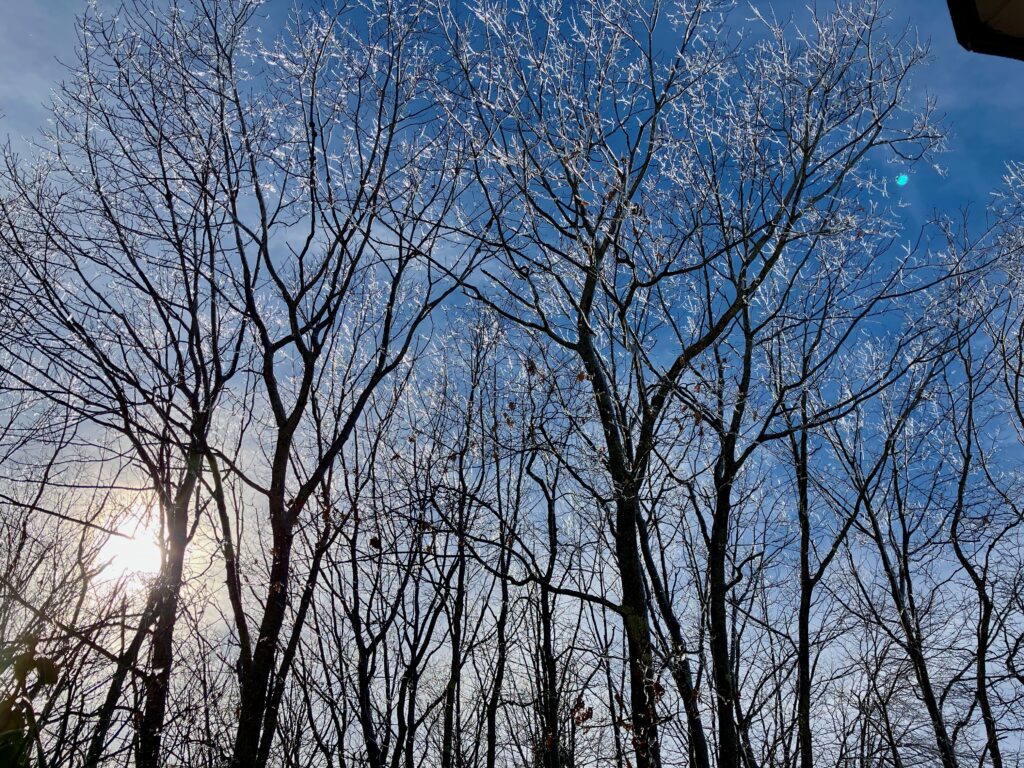I took this picture on Sunday afternoon. Late Satrurday night, the snow turned to freezing rain, covering even the top branches of the oaks with glittering coats of ices.

Oaks covered with ice
All the ways Maine is wicked good
I took this picture on Sunday afternoon. Late Satrurday night, the snow turned to freezing rain, covering even the top branches of the oaks with glittering coats of ices.

Oaks covered with ice
 Bishop’s weed or Aegopodium podagraria is a native of Eurasia, also known as ground elder, herb gerard, goutweed, gout wort, and snow-in-the-mountain. Like its cousin, Queen Anne’s Lace, another Eurasian import, (Daucus carota) Bishop’s weed is a perennial and member of the carrot family. Bishop’s Weed was brought to the U.S. as an ornamental ground cover in the late 1800s. It is still very common in Europe and has spread to most of the U.S.
Bishop’s weed or Aegopodium podagraria is a native of Eurasia, also known as ground elder, herb gerard, goutweed, gout wort, and snow-in-the-mountain. Like its cousin, Queen Anne’s Lace, another Eurasian import, (Daucus carota) Bishop’s weed is a perennial and member of the carrot family. Bishop’s Weed was brought to the U.S. as an ornamental ground cover in the late 1800s. It is still very common in Europe and has spread to most of the U.S.

The Forsythia was stunning this year, but the weather for taking pictures of the Forsythia was less stunning. It was a strange winter, and so far, a strange spring. Lots of rain, lots of over cast skies, and the spring migration of birds was a little behind the usual schedule. That said, the Ruby-throated hummingbirds were back the first week of May, and they seem ravenous and populous.
Though I missed pictures of the Forsythia, here are some magnolias.




I got a chance to visit Wolfe’s Neck Woods State Park, near Freeport today. I’m hoping to go there again some day. There are several trails, ranging from the “wheel chair accessible” White Pines Trail to the slightly rugged, winding Harraseeket trail, which runs partway along Harraseeket river, and partway along Casco Bay. Today was one of those Maine Autumn days that threaten to rain, but never quite deliver. I took a lot of photographs.

Sugar Maple eaves already showing mottled red and orange, striking against the bright green of other deciduous trees’ leaves.

Not sure what species of fungus this mushroom is, but there were many of them, large and small.



Lady Slipper with seed-pod.

Partridge Berry


Partridge Berry Mitchella repens L.
Partridge Berry is one of the plants I love. It’s really common in the Eastern U.S. and it’s a favorite food for grouse. It takes two flowers to produce a single berry.

Most of these saplings are less than twenty years old.


Glacial gift
The floor of this forest is rotted vegetation over soil. A foot or three (at most) of soil that’s covering bedrock, or what’s locally called ledge. It’s the same rock you see as outcroppings along the Maine and N.H. and Canadian coastline.

I don’t know what this is. It’s shrub; maybe an Elder species?

A spray of partially turned Sugar Maple leaves, mottled with bright orange.
As a kid in the 1970s who spent part of most summers in Maine, Lupines were one of the major road side attractions in Maine. They started showing in June, and sometimes, as you went North, you could still see them in early July. They’re not the native (possibly extinct) Lupine (Lupinus perennis); these are cultivated (though it’s quite possible that there’s been some unsupervised crossing) Lupinus polyphyllus, originally a West coast native. It’s a plant I’m going to plant, someday, on the edge of a field or road. Lupines are fairly easy to cultivate, and thrive in somewhat harsh conditions with poor soil.

Lupines
You might be familiar with the fabulous book written and illustrated by Barbara Cooney: Miss Rumphius, about a woman who traveled the world, and scattered and collected and distributed lupine seeds all over Maine.

To be truthful, I’m not sure these are apple blossoms; I think they might be crab apple blossoms. But they are beautiful.



May 17, 2018

May 18, 2018

May 18, 2018

May 19, 2018
 These are native New England orchids, and there are three varieties; this one, the white-and-pink variety, and the very rare yellow variety.
These are native New England orchids, and there are three varieties; this one, the white-and-pink variety, and the very rare yellow variety.
Lady Slippers propagate by seeds, but it takes several years before they bloom, and they generally die when transplanted because they have a fragile root system.
At the bottom on the left of the photo is a Star flower, another spring blossom.